France–Spain relations
France–Spain relations are Bilateral relations between France and Spain, in which both share a long border across the Pyrenees, other than one point which is cut off by Andorra. As two of the most powerful kingdoms of the early modern era, France and Spain fought a 24-year war (the Franco-Spanish War) until the signing of the Treaty of the Pyrenees in 1659. The treaty was signed on the Pheasant Island between the two nations, which has since been a condominium, changing its allegiances each six months.
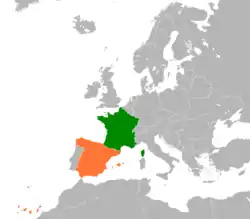 | |
France |
Spain |
|---|---|
Both nations are member states of the European Union (and both nations utilize the Euro as currency) and are both members of the Council of Europe, Latin Union, OECD, NATO and the United Nations.
Country comparison
| Coat of arms | 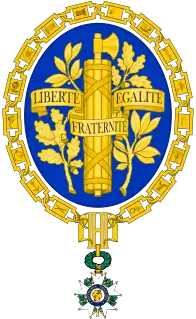 |
.svg.png.webp) |
| Population | 67,087,000 | 46,354,321 |
| Area | 674,843 km2 (260,558 sq mi) | 505,990 km2 (195,360 sq mi) |
| Population density | 116/km2 (301/sq mi) | 92/km2 (238/sq mi) |
| Capital | Paris | Madrid |
| Largest city | Paris – 2,234,105 (12,161,542 Metro) | Madrid – 3,141,991 (6,700,000 Metro) |
| Government | Unitary semi-presidential constitutional republic | Unitary parliamentary constitutional monarchy with regional devolved powers |
| Current Leader | President Emmanuel Macron Prime Minister Jean Castex |
Monarch Felipe VI Prime Minister Pedro Sánchez |
| Official languages | French | Spanish |
| Main religions | 58% Christianity, 31% non-religious, 7% Islam, 1% Judaism, 1% Buddhism, 2% other |
68% Catholic Christians, 27% not religious, 2% other religions |
| Ethnic groups | 86% French, 7% other European, 7% North African, other Sub-Saharan African, Indochinese, Asian, Latin American and Pacific Islander. |
88% Native-born Spanish citizens, 12% immigrants (57% of them from Spain's former colonies in Latin America, the rest are |
| GDP (nominal) | US$2.590 trillion, ($43,550 per capita) | US$1.864 trillion, ($40,290 per capita) |
History
Medieval
The entire mainlands of both Gaul and Hispania were possessions of the Roman Empire.[1]
While the term "Spain" may be improper when used to refer to France–Spain relations before the union of the Crown of Castile and the Crown of Aragon in 1476, there has always been important relations between what are now France and Spain.
One important feature of those early relations was that counts from the Marca Hispanica & Navarre fought shoulder to shoulder with Frankish Kings (during the Carolingian dynasty), to protect Europe from the Al Andalus Muslim kingdom. Barcelona was a County of the Frankish Empire, under protection of the Franc Imperator.
This vassality of Marca Hispanica and Navarre to the Frankish empire remained effective up to 985. At that point, because his armies were mobilized in the Verdum's county, Lothair of France and his Byzantine allies did not assist Navarre & Marca Hispanica in its defense against the Caliph, implying that they failed to defend Barcelona from the Arabs. Almanzor did not stay in the cities (the first assault was launched 6 July 985; withdrew their troops 23 July), but this incursion was arguably the first step of a process of independence of the county of Barcelona from the kingdom of France, and heralded what would become the Aragon kingdom. While independent of France and integrated in the Crown of Aragon, Barcelona remained legally a county of France and the King of France retained a de jure right to vote in the Barcelone Courts in the next centuries. This situation generated numerous territorial conflicts between the two kingdoms[2] to control what is now the south of France and the north of Spain (the support of Aragon to the Count of Toulouse, death in Perpignan of Philip III of France married to Isabel of Aragon, and Albigenses Crusades are some of the most famous examples) and played a significant political role in the start of the Catalan Revolt which ended with the treaty of Pyrenees.
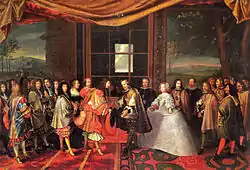
17th century
The Franco-Spanish War broke out in 1635, when French king Louis XIII felt threatened that his entire kingdom was bordered by Habsburg territories, including Spain. In 1659, the Treaty of the Pyrenees ended the war and ceded the Spanish-possessed Catalan county of Roussillon to France, which had supported the Principality of Catalonia in a revolt against the Spanish crown. Western Flanders, roughly equivalent to the modern French department of Nord, was also ceded.[3] An anomaly of the treaty was that although all villages in Roussillon were ceded to France, Llívia was deemed to be a city and was therefore retained by Spain to the present day as an exclave 3 kilometres (2 mi) into France.[4] The treaty was signed on Pheasant Island, an uninhabited, unserviced island in the Bidasoa river between the French commune of Hendaye and the Spanish municipality of Irun. Both settlements, and therefore their countries, took sovereignty of the island for six months out of each year.[5] After Philip IV of Spain defeat, Marie-Thérèse of Austria, Infant of Spain, was married to the king of France Louis XIV.

18th century
In 1701, after the death of the last Habsburg king of Spain, Charles II, the French House of Bourbon, led by Louis XIV, staked a claim to the Spanish throne. The war ended with the Bourbon Philip V being recognised as King of Spain.[6] The House of Bourbon remains on the Spanish throne to the present day.[7]
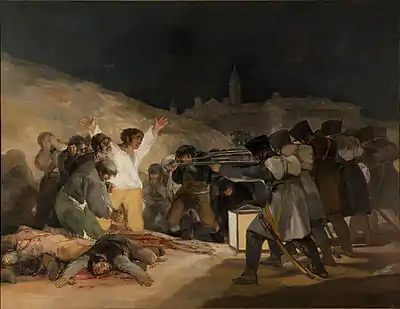
19th century
Revolutionary France and Bourbon Spain signed the Treaty of San Ildefonso in 1796 as part of their shared opposition to Britain. The relationship spoiled after defeat in 1805 at the Battle of Trafalgar, and in 1808, French Emperor Napoleon named his brother Joseph as King of Spain as part of a plan to get closer to invading Britain's ally, Portugal. The Bourbon king Ferdinand VII was imprisoned by Napoleon, but still remained recognised as Spanish monarch by Napoleon's adversaries. He returned to the throne in 1813 after Spain, Britain and Portugal's victory in the Peninsular War.
Aftermath of the Nationalist Victory in the Spanish Civil War and the outbreak of World War II, 1939–1945
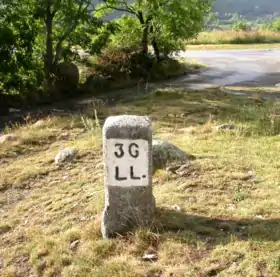
When the Nationalist forces of General Francisco Franco were victorious at the end of the Spanish Civil War in 1939, there was discussion of Llívia, a small exclaved Spanish city 3 km (2 mi) into France, becoming territory of the defeated Republican Army. No conclusion was reached and the French authorities allowed the Nationalists to occupy Llívia.[4]
France had tentatively supported the Spanish Republicans during the civil war, and had to readjust its foreign policy towards Spain in the fact of the Nationalists' imminent victory. On 25 February 1939, France and Francoist Spain signed the Bérard-Jordana Agreement, in which France recognized the Franco government as the legitimate government of Spain and agreed to return Spanish property of various types (including, among others. weapons and munitions, gold reserves, art and livestock) previously in the possession of the Republicans to the Nationalists. In return, the new Spanish government agreed to good neighborly relations, colonial cooperation in Morocco, and made informal assurances to repatriate the more than 400,000 refugees that had fled from the Nationalists' Catalonia Offensive into France in early 1939.[8][9] Philippe Pétain, later the leader of the Vichy regime during the German occupation of France, became the French ambassador to the new Spanish government.[10] Spain would later undermine the spirit of the Bérard-Jordana Agreement when the Spanish entry into the Anti-Comintern Pact and subsequent alignment with the German and Italian fascists resulted in a military buildup in colonial Morocco, in spite of the promise of cooperative policy in that area.[11] Spain was however unwilling to be drawn into World War II, and had announced its intentions to remain neutral in German expansionist designs to France as early as the 1938 Sudeten crisis.[12] This scepticism towards Spanish involvement on German behalf was further strengthened when the Spanish government got news of German cooperation with the Soviet Union, formerly a supporter of the Spanish Republicans during the civil war, under the 1939 Molotov–Ribbentrop Pact.[13] Although Spain remained neutral, Spanish volunteers were allowed to fight on the side of the Axis powers as part of the German "Blue" 250th Infantry Division.[14][15]
With the restoration of the French government in the latter part of the Second World War, relations between Spain and France became more complex. Exiled Spanish Communists had infiltrated northern Spain from France via the Val d'Aran but were repelled by Franco's army and police forces.[16] The border between the two countries was temporarily closed by the French in June 1945.
Between World War and Cold War, 1945–1949
The border between France and Spain was closed indefinitely on 1 March 1946, following the execution of the Communist guerrilla Cristino García in Spain. The Franco government criticized the action, commenting that many refugees from France had used the same border to escape to safety in Spain during the war. Several days after the border closing, France issued a diplomatic note with the United States and Britain calling for the formation of a new provisional government in Madrid.[17] Additionally, Spain's formerly close relationship with Italy and Nazi Germany led to suspicion and accusations. Some Nazis and French collaborators fled to Francoist Spain following the end of the war, most notably Pierre Laval, who was turned over to the Allies in July 1945. One French report claimed that 100,000 Nazis and collaborators were sheltered in Spain. The Soviet Union declared there were 200,000 Nazis in the country and that Franco was manufacturing nuclear weapons and intended to invade France in 1946.[18]
The Franco regime during the Cold War, 1949–1975
With the advent of the Cold War, relations gradually improved. The Pyrenean border was re-opened again in February 1948.[19] Several months later France (along with Britain) signed a commercial agreement with the Franco government.[20] Relations further improved in 1950 when the French government, concerned about international subversion, forced the Spanish Communist Party to leave France.[21]
Franco-Spanish relations would become more tense with the rise to power of Charles de Gaulle, especially when the rebel French general Raoul Salan found sanctuary among Falangists in Spain for six months in 1960–61. Nevertheless, some commercial relations were done, the French finance minister visited Madrid in April 1963 to conclude a new commercial treaty.[22] Nevertheless, is undoubted that the aggressive rhetoric that both Franco and de Gaulle used against each other did not improve the relationship between the countries.
Post-Francoist Spain, 1975–2000
When Spain was led by general Francisco Franco, the French believed that ETA attacks were aimed at overthrowing the government of Franco, and did not feel targeted by ETA. The reason for this was the help that regime of Franco gave to the terrorist organization OAS and because of that when ETA started to kill people de Gaulle gave them shelter in the French Basque Country, the so-called Le Sanctuaire. However, when the attacks continued after the death of Franco, France started a collaboration with the Spanish government against ETA.
21st century
.jpg.webp)
In recent years, due to an improving economy in Spain, the balance between France and Spain has shifted somewhat. The balance has also changed because of liberalisation of the Spanish society since the death of Franco in 1975.
France is one of the largest trading partners of Spain.[23] In March 2015, Philip VI of Spain chose to go to France as its first diplomatic visit since his accession. The visit was widely regarded as a way to hail the excellent bilateral relations between France and Spain.[24][25]
G6
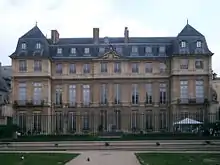
Spain and France along with Germany, Italy, United Kingdom and Poland are members of the G6, a group of the 6 most important countries of the European Union. Through the G6, France and Spain cooperate on the areas of defence, economic development and European Constitution.
Cultural exchange
A Eurostat publication estimated that 122,385 French citizens live in Spain and 128,000 Spanish citizens live in France,[26] while it is also estimated that 144,039 people in France were born in Spain.[27] The Spanish Civil War and hardship immediately after spurred Spanish migration to the more developed and democratic France, which had a labour shortage in the aftermath of the Second World War.[28] The Spanish artist Pablo Picasso, resident in the French capital Paris since 1901, was refused naturalisation shortly after Franco took control of Spain, but remained in Paris until his death in 1973.[29]
Resident diplomatic missions
|
|
_01.jpg.webp) Embassy of France in Madrid
Embassy of France in Madrid Consulate-General of France in Barcelona
Consulate-General of France in Barcelona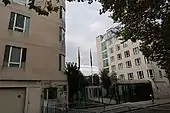 Embassy of Spain in Paris
Embassy of Spain in Paris Consulate-General of Spain in Bordeaux
Consulate-General of Spain in Bordeaux.jpg.webp) Consulate-General of Spain in Lyon
Consulate-General of Spain in Lyon
References
- "Maps of the Roman Empire". Roman-empire.net. Archived from the original on 12 May 2016. Retrieved 1 August 2016.
- Bernerd C. Weber, The Conference of Bayonne, 1565: An Episode in Franco-Spanish Diplomacy, The Journal of Modern History, Vol. 11, No. 1 (Mar., 1939), pp. 1-22.
- "The History of the Languedoc: The Treaty of the Pyrenees". Midi-france.info. Retrieved 1 August 2016.
- "The exclave of Llivia – Iberianature: The travel guide to Spain". Iberianature.com. 15 February 2010. Retrieved 1 August 2016.
- "Pheasant Island". Bidasoaturismo.com. Retrieved 1 August 2016.
- "The Spanish Succession and the War of the Spanish Succession". Spanishsuccession.nl. Retrieved 1 August 2016.
- James Falkner, The War of the Spanish Succession 1701–1714 (2015) excerpt
- – via Wikisource.
- Osmanczyk, Edmund J. (1990) [1985]. "Berard-Jordan Agreement, 1939". The Encyclopedia of The United Nations and International Relations (2nd ed.). Bristol: Taylor and Francis. pp. 92. ISBN 0850668336.
- Catala, Michel (1997). "L'ambassade de Pétain (mars 1939 - mai 1940)". Vintième Siècle. Revue d'Histoire (in French). 55 (55): 29–42. doi:10.2307/3770543. JSTOR 3770543.
- Stone, Glyn (1989). "The European Great Powers and The Spanish Civil War, 1936-1939". In Boyce, Robert; Robertson, Esmonde M. (eds.). Paths to War: New Essays on the Origins of the Second World War. Houndmills: Macmillan. p. 221. ISBN 9781349203338.
- Duroselle, Jean-Baptiste (2004). "Chapter XIII: The Failure of the Grand Alliance (March–August 1939)". France and the Nazi Threat: The Collapse of French Diplomacy 1932-1939. Enigma Books. ISBN 1929631154.
- Beevor, Antony (2012). "The Outbreak of War: June–August 1939". The Second World War. New York City: Little, Brown and Company.
- Kleinfeld, Gerald R.; Tambs, Lewis A. (1979). Hitler's Spanish Legion: The Blue Division in Russia. Southern Illinois University Press. ISBN 0809308657.
- Krammer, Arnold (1973). "Spanish Volunteers against Bolshevism". The Russian Review. 32 (4): 388–402. doi:10.2307/127582. JSTOR 127582.
- Payne, S.G. The Franco Regime: 1936–1939. Madison: University of Wisconsin, 1987. p 345.
- Payne 1987, p. 357-58.
- Payne 1987, p. 356.
- Payne 1987, p. 381.
- Payne 1987, p. 382.
- Payne 1987, p. 397.
- Payne 1987, p. 530.
- "OEC - Spain (ESP) Exports, Imports, and Trade Partners". Atlas.media.mit.edu. Retrieved 1 August 2016.
- "Felipe VI elige Francia para su primera gran visita de Estado | España | EL PAÍS". Politica.elpais.com. 23 March 2015. Retrieved 1 August 2016.
- "Première visite d'Etat en France du roi d'Espagne". Le Figaro. 24 March 2015. Retrieved 1 August 2016.
- "Europe: where do people live? | World news". Theguardian.com. Retrieved 1 August 2016.
- "Document of statistics" (XLS). Oecd.org. Retrieved 1 August 2016.
- Hamilton, Kimberly. "The Challenge of French Diversity | migrationpolicy.org". Migrationinformation.org. Retrieved 1 August 2016.
- Riding, Alan (28 May 2003). "Picasso in Paris - A Suspect, Never a Citizen". NYTimes.com. FRANCE. Retrieved 1 August 2016.
Further reading
- Bertrand, Louis and Charles Petrie. The History of Spain (2nd ed. 1956) online
- Carr, Raymond. Spain, 1808–1975 (2nd ed 1982), a standard scholarly survey
- Cortada, James W. Spain in the Twentieth-Century World: Essays on Spanish Diplomacy, 1898-1978 (1980) online
- Cortada, James W. A Bibliographic Guide to Spanish Diplomatic History, 1460-1977 (Greenwood Press, 1977) 390 pages
- Folmer, Henry D. Franco-Spanish Rivalry in North America, 1524-1763 (1953) online
- Hill, David Jayne. A history of diplomacy in the international development of Europe (3 vol. 1914) online v 3, 1648–1775.
- Kamen, Henry. Empire: how Spain became a world power, 1492-1763 (2004).
- McKay, Derek, and Hamish M. Scott. The rise of the great powers 1648–1815 (1983).
- Merriman, John. A History of Modern Europe: From the Renaissance to the Present (3rd ed. 2009, 2 vol), 1412 pp; university textbook
- Mowat, R. B. A History of European Diplomacy, 1451–1789 (1928) online at Questia
- Mowat, R. B. A History of European Diplomacy 1815–1914 (1922), basic introduction onlinr
- Payne, Stanley G. A History of Spain and Portugal (2 vol 1973) full text online vol 1 before 1700; full text online vol 2 after 1700; a standard scholarly history
- Petrie, Charles. Earlier Diplomatic History, 1492–1713 (1949) online; at Questia
- Price, Roger. A Concise History of France (1993) excerpt and text search
- Raymond, Gino. Historical Dictionary of France (2nd ed. 2008) 528pp